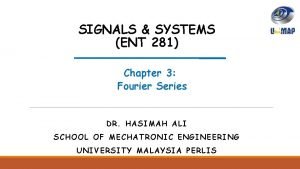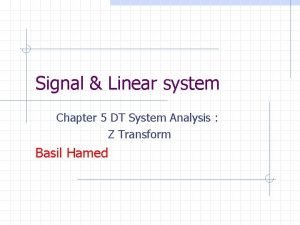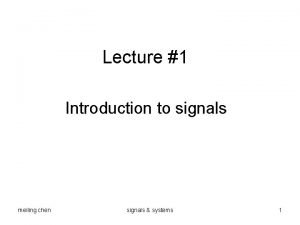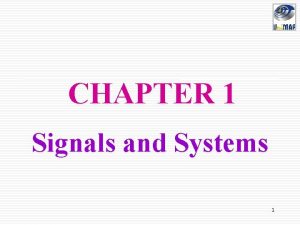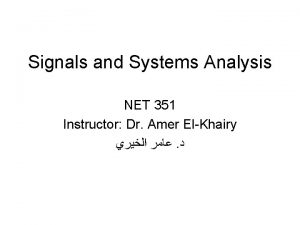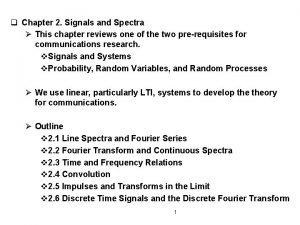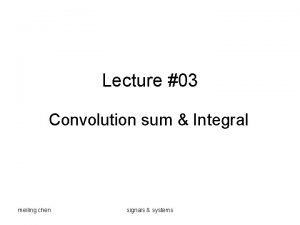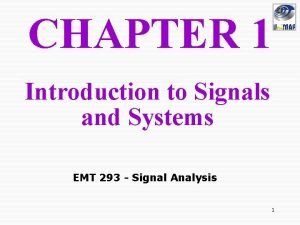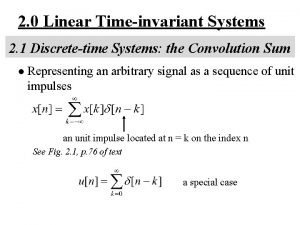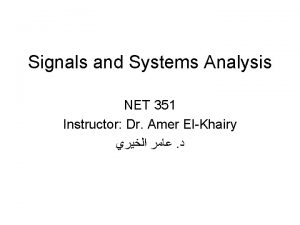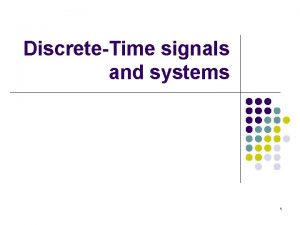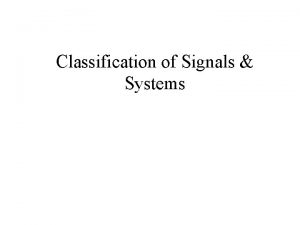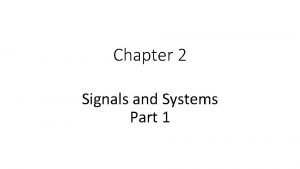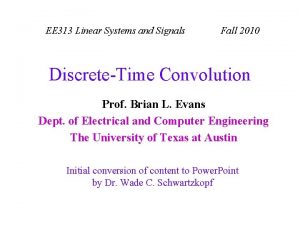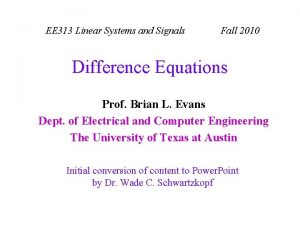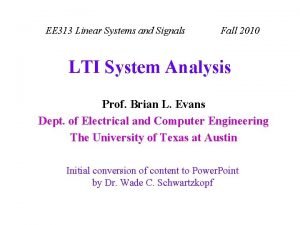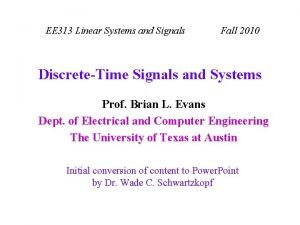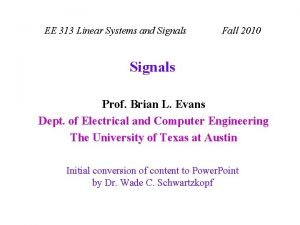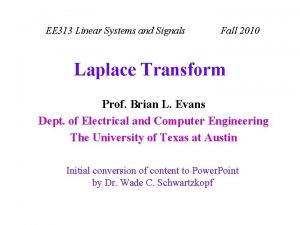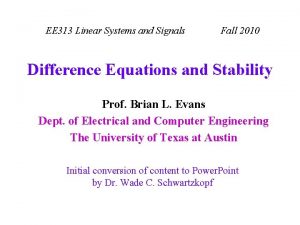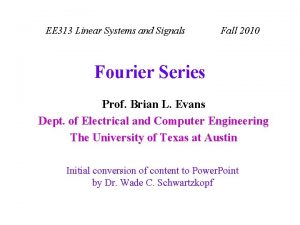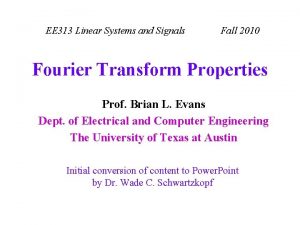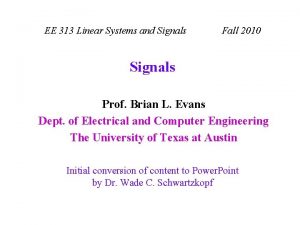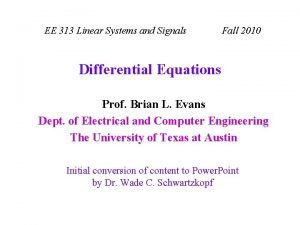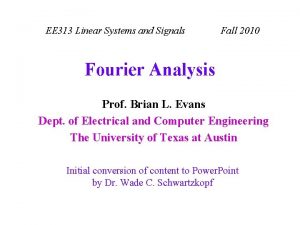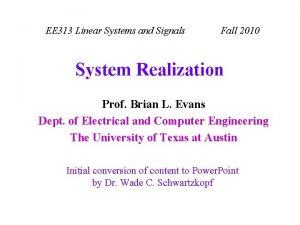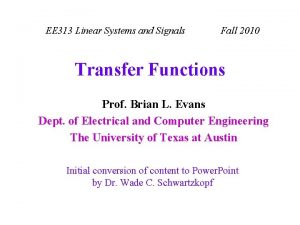EE 313 Linear Systems and Signals Fall 2010












![Discrete-time Convolution Preview • Assuming that h[n] has finite duration from n = 0, Discrete-time Convolution Preview • Assuming that h[n] has finite duration from n = 0,](https://slidetodoc.com/presentation_image_h/df0384fe2bfa04b3df50cabf7dc73644/image-13.jpg)


- Slides: 15

EE 313 Linear Systems and Signals Fall 2010 Continuous-Time Convolution Prof. Brian L. Evans Dept. of Electrical and Computer Engineering The University of Texas at Austin Initial conversion of content to Power. Point by Dr. Wade C. Schwartzkopf

Convolution Integral • Commonly used in engineering, science, math • Convolution properties – – Commutative: f 1(t) * f 2(t) = f 2(t) * f 1(t) Distributive: f 1(t) * [f 2(t) + f 3(t)] = f 1(t) * f 2(t) + f 1(t) * f 3(t) Associative: f 1(t) * [f 2(t) * f 3(t)] = [f 1(t) * f 2(t)] * f 3(t) Shift: If f 1(t) * f 2(t) = c(t), then f 1(t) * f 2(t - T) = f 1(t - T) * f 2(t) = c(t - T). – Convolution with impulse, f(t) * d(t) = f(t) – Convolution with shifted impulse, f(t) * d(t-T) = f(t-T) 2 important later in modulation

Graphical Convolution Methods • From the convolution integral, convolution is equivalent to – Rotating one of the functions about the y axis – Shifting it by t – Multiplying this flipped, shifted function with the other function – Calculating the area under this product – Assigning this value to f 1(t) * f 2(t) at t 3

Graphical Convolution Example • Convolve the following two functions: f(t) g(t) 3 2 * t t 2 -2 2 • Replace t with t in f(t) and g(t) • Choose to flip and slide g(t) since it is simpler and symmetric 3 g(t-t) • Functions overlap like this: 2 f(t) -2 + t 2+t 2 t 4

Graphical Convolution Example • Convolution can be divided into 5 parts I. t < -2 • • Two functions do not overlap Area under the product of the functions is zero 3 2 -2 + t • • f(t) 3 Part of g(t) overlaps part of f(t) Area under the product of the functions is t 2 2+t -2 t < 0 II. g(t-t) 2 -2 + t f(t) 2+t t 2 5

Graphical Convolution Example III. 0 t < 2 • • Here, g(t) completely overlaps f(t) Area under the product is just 3 2 f(t) 2 2+t -2 + t IV. 2 t < 4 • • Part of g(t) and f(t) overlap Calculated similarly to -2 t < 0 t 4 V. • • g(t) and f(t) do not overlap Area under their product is zero g(t-t) t 3 g(t-t) 2 f(t) -2 + t 2+t 6

Graphical Convolution Example • Result of convolution (5 intervals of interest): y(t) 6 t -2 0 2 4 7

Convolution Demos • Johns Hopkins University Demonstrations http: //www. jhu. edu/~signals Convolution applet to animate convolution of simple signals and hand-sketched signals Convolve two rectangular pulses of same width gives a triangle (see handout E) • Some conclusions from the animations Convolution of two causal signals gives a causal result Non-zero duration (called extent) of convolution is the sum of extents of the two signals being convolved 8

Transmit One Bit • Transmission over communication channel (e. g. telephone line) is analog receive ‘ 0’ bit input Tp t x(t) -A A t Tp ‘ 1’ bit t Communication Channel Model channel as LTI system with impulse response h(t) Assume that Th < Tp output Th y(t) t -A Th receive ‘ 1’ bit A Th 1 Th Th+Tp t Th Th+Tp 9 t

Transmit Two Bits (Interference) • Transmitting two bits (pulses) back-to-back will cause overlap (interference) at the receiver * A = 1 Th+Tp 2 Tp Tp ‘ 1’ bit t Th t -A Th ‘ 0’ bit Assume that Th < Tp • How do we prevent intersymbol interference at the receiver? t Tp ‘ 1’ bit ‘ 0’ bit intersymbol interference 10

Transmit Two Bits (No Interference) • Prevent intersymbol interference by waiting Th seconds between pulses (called a guard period) * A = 1 Th+Tp Tp ‘ 1’ bit Th+Tp Th t t -A Th ‘ 0’ bit Assume that Th < Tp t Th Tp ‘ 1’ bit ‘ 0’ bit • Disadvantages? 11

Discrete-time Convolution Preview • Discrete-time convolution • Continuous-time convolution • For every value of n, we compute a new summation • For every value of t, we compute a new integral x[n] h[n] LTI system represented by its impulse response y[n] x(t) h(t) LTI system represented by its impulse response y(t) 12
![Discretetime Convolution Preview Assuming that hn has finite duration from n 0 Discrete-time Convolution Preview • Assuming that h[n] has finite duration from n = 0,](https://slidetodoc.com/presentation_image_h/df0384fe2bfa04b3df50cabf7dc73644/image-13.jpg)
Discrete-time Convolution Preview • Assuming that h[n] has finite duration from n = 0, …, N-1 • Block diagram of an implementation (finite impulse response digital filter): see slide 2 -4 x[n] h[0] z-1 … z-1 h[1] h[2] … h[N-1] S y[n] 13

Philosophy • Pillars of electrical engineering (related) • Finite-state machines for digital input/output Fourier analysis Probability and random processes • Pillars of computer engineering (related) System state Complexity EE 313 is pre-requisite for EE 351 K Finite number of states Models all possible inputoutput combinations Can two outputs be true at the same time? • Given output observation, work backwards to inputs to see if output is possible • This is called observability 14

Corporate Technical Ladder • Test Engineer BS degree Test other people’s designs Starting salary: $65, 000 Ph. DEE 2 Director Eng. • Design Engineer MS degree, or BS degree plus 2 years experience and design short courses Design new products Starting salary: $75, 000 • What about the Ph. D. ? ¾ of Ph. D. ’s to industry ¼ of Ph. D. ’s to academia CTO VP, Eng. Technical Staff (R&D) Ph. DEE 1 Proj. Management MSEE Design Eng. BSEE Tech. (1) (2) Test Eng. Technician 15 Ph. D. based on system prototyping Ph. D. with significant theoretical results
 Animals and human language chapter 2
Animals and human language chapter 2 What was the first human language
What was the first human language Communicative signals and informative signals
Communicative signals and informative signals Trigonometric form of fourier series
Trigonometric form of fourier series Signals and systems oppenheim solutions chapter 5
Signals and systems oppenheim solutions chapter 5 Precedence rule for time shifting and scaling
Precedence rule for time shifting and scaling Precedence rule in signals and systems
Precedence rule in signals and systems Convolution sum in signals and systems
Convolution sum in signals and systems Line spectrum in signals and systems
Line spectrum in signals and systems Convolution sum signals and systems
Convolution sum signals and systems Introduction to signals and systems
Introduction to signals and systems Convolution sum in signals and systems
Convolution sum in signals and systems Signals and system
Signals and system L
L Classification of signals and systems
Classification of signals and systems Signals and systems
Signals and systems



